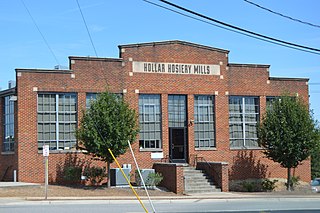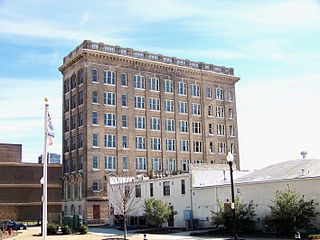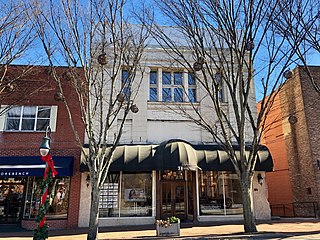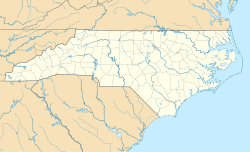
The Old North Carolina Mutual Life Insurance Company Building, also known as the Mechanics and Farmers Bank Building, is an office building at 114-116 West Parrish Street in downtown Durham, North Carolina. It formerly served as the headquarters for the North Carolina Mutual Life Insurance Company, which was formerly one of the nation's largest companies founded and owned by African-Americans. The building was declared a National Historic Landmark in 1975.

The Farmers' and Exchange Bank is a historic commercial building in Charleston, South Carolina. Built in 1853–54, it is an architecturally distinctive building, with Moorish Revival features rarely seen in the United States. The building is recognizable for its use of muqarnas—characteristic of Persian and North African architecture—as well as its large arched windows and striking red sandstone facade. It was declared a National Historic Landmark in 1973.

The State Bank of North Carolina is the oldest surviving commercial building in Raleigh, North Carolina and was the first state-sponsored banking institution constructed in North Carolina. The bank was incorporated in 1810, but during the War of 1812 cash was moved inland to banks in Raleigh and Tarboro for fears that the British Army would attack the coast. The increase in money deposits resulted in the State Bank's construction in 1813. Jacob Johnson, the father of future President Andrew Johnson, was once employed at the bank. The building was listed on the National Register of Historic Places in 1970 and is a Raleigh Historic Landmark. It is located in the Capitol Area Historic District.

Saint Mary's School is a private independent Episcopal college-preparatory, boarding and day school for girls in grades 9–12. Located in Raleigh, North Carolina, Saint Mary's School operates as an independent school with a historic affiliation with the Episcopal Church including an Episcopal chapel, St. Mary's Chapel, on the school's grounds. The school formerly operated as Saint Mary's College and for many decades educated young women in grades 11–12 and their freshman and sophomore years in college. The school changed to a four year high school in 1998, at which point the name reverted to Saint Mary's School, the original name of the institution when it was founded in 1842.

The Nissen Building is a 283 ft 18-story skyscraper in Winston-Salem, Forsyth County, North Carolina, built in 1927. It was the largest building in the city, succeeding the Hotel Robert E. Lee, and the tallest building in North Carolina from 1927 to 1929, when it was succeeded by the Reynolds Building; all three buildings were in Winston-Salem. The Nissen Building was named to the National Register of Historic Places March 17, 1983, with a boundary increase in 2004 to include a one-story addition built in 1969. With the spire on top, its height is 102.1m.
Mowbray & Uffinger comprised an architectural partnership in New York City formed in 1895. Known for bank buildings and as vault engineers they designed over 400 banks in the pre-World War II era throughout the country. The principals were Louis Montayne Mowbray (1867-1921) and Justin Maximo Uffinger Sr. (1871-1948).

Richard Sharp Smith was an English-born American architect, noted for his association with George W. Vanderbilt's Biltmore Estate and Asheville, North Carolina. Smith worked for some of America's important architectural firms of the late 19th century—Richard Morris Hunt, Bradford Lee Gilbert, and Reid & Reid—before establishing his practice in Asheville. His most significant body of work is in Asheville and Western North Carolina, including dozens of buildings that are listed on the National Register of Historic Places or are contributing structures to National Register Historic Districts.

Biltmore–Oteen Bank Building is a historic bank building located at Biltmore Village, Asheville, Buncombe County, North Carolina. It was built between 1925 and 1930, and is a two-story, brick building with Colonial Revival / Georgian Revival design details. It is a thin, wedge-shaped building featuring concrete detail and Doric order type pilasters.

Milton State Bank, also known as the Branch Bank of the Bank of the State of North Carolina at Milton, is a historic bank building located at Milton, Caswell County, North Carolina. It was built in 1860, and is a two-story, three bay by five bay, Greek Revival-style brick building. Its brickwork is laid Flemish bond. It housed a bank on the first floor and residential unit on the second. It housed a bank until about 1914. From about 1914 to 1963 the building served as a combination residence and the Milton Post Office. It was subsequently converted to residential usage.

Hollar Hosiery Mills-Knit Sox Knitting Mills is a historic knitting mill located at Hickory, Catawba County, North Carolina. It consists of two mill brick manufacturing buildings and a boiler house that were connected by a hyphen in the mid-1960s. The first mill building was built about 1930, and is a one- to two-story, 16 bay, brick veneer structure. The boiler house was also built about 1930, and is a small, brick building, with its flat roof and terra cotta coping. The hosiery yarn mill was built about 1940, and is two-story, six bay by 10 bay, brick-veneered building. Both mill buildings feature banks of steel-sash factory windows. The knitting mill operated until 1968.

Third National Bank Building is a historic office building located at Gastonia, Gaston County, North Carolina, USA. It was designed by Milburn, Heister & Company and built in 1923. It is an eight-story, four bay wide, English Tudor Revival-style steel frame building. It is sheathed in dark red brick and stone with a molded terra cotta covered top story. It features a projecting main entrance with a two-story segmental arched opening.

First National Bank Building, also known as the Lawyers Building, is a historic office building located at Gastonia, Gaston County, North Carolina. It was designed by Wilson & Sompayrac and built in 1916–1917. It is a seven-story, rectangular, Classical Revival-style steel frame building. It is sheathed in cream-colored brick with limestone and terra cotta trim.

Downtown Mount Holly Historic District is a national historic district located at Mount Holly, Gaston County, North Carolina. https://visitmounthollync.com/ It encompasses 25 contributing buildings and 1 contributing structure in the central business district of Mount Holly. The buildings were built between about 1883 and 1960, and characterized by one- and two-story brick commercial buildings. Notable buildings include the Classical Revival style Mount Holly Bank, Evangelical Lutheran Church of the Good Shepherd (1903), First Presbyterian Church (1927), and Charlie's Drugs and Sundries (1960).

The Former Citizens Bank and Trust Company Building is a historic bank building located at Waynesville, Haywood County, North Carolina. It was built in 1921, and is a two-story, brick and marble front rectangular building in the Classical Revival style. It measures 76 feet by 31 feet and features a tall parapet faced with marble block that rises above the cornice. The bank ceased operation in 1932, and the building has since housed retail businesses.

Peoples Bank Building is a historic bank building located at Kinston, Lenoir County, North Carolina. It was built about 1923, and is a modest two-story, cinder block building, sheathed in brick and in the Classical Revival style. It has a flat roof with raised parapet ornamented by brick panels outlined in limestone. The front facade features a large arched opening with a stone surround. The building housed one of only two African-American-owned banks to operate in the city of Kinston. The bank ceased to operate in 1931, and the building has housed a number of commercial enterprises.

Bank of French Broad, also known as the Robert Building, is a historic bank building located at Marshall, Madison County, North Carolina. The Bank of French Broad and adjacent Robert Building were designed by noted Asheville architect James J. Baldwin and built in 1922–1923. They are two- to three-story, Classical Revival-style brick buildings. The two buildings were joined into one building in the late 1970s to early 1980s.

Old Brick House is a historic home located at Elizabeth City, Pasquotank County, North Carolina. It was built about 1750, and is a 1+1⁄2-story frame dwelling with brick gable ends. It sits on a raised brick basement, has a gable roof with dormers, and two interior end chimneys with molded caps. The interior features a richly carved mantel with an elaborate broken ogee pediment. It is one of the few brick-end buildings in the state. The brickwork is laid in Flemish bond with glazed headers. It is a member of the small group of 18th century frame houses with brick ends in northeast North Carolina; the group includes the Sutton-Newby House and the Myers-White House.

Bank of Tryon Building, also known as the Tryon Daily Bulletin Building and Hester Building, is a historic bank building located at Tryon, Polk County, North Carolina. It was built in 1907–1908, and is a two-story, two-bay, Romanesque Revival-style brick-and-stone building. It features granite quoins, second-story Palladian-type windows, and a projecting parapet. Since 1935, the building has been home to the Tryon Daily Bulletin, the world's smallest daily newspaper.

Planters Building, also known as the First Union Bank Building, is a historic office building located at Lumberton, Robeson County, North Carolina. It was designed by the firm of Wilson, Berryman & Kennedy and built in 1925–1926. It is a five-story, Classical Revival-style steel frame building sheathed in brick and rusticated cast concrete. The ground levels feature round arched windows and the main entrance is reached through a barrel-arched, coffered vault. Attached to the corner of the building is an original rectangular iron-cased clock.

Citizens Bank Building, also known as the Yancey County Public Library Building, is a historic bank building located at Burnsville, Yancey County, North Carolina. It was built in 1925, and is a three-story, yellow brick Renaissance Revival-style building. The front facade features fluted Corinthian order pilasters and arched brick openings. The building housed a bank until 1972, when it was donated for use as a county library.























